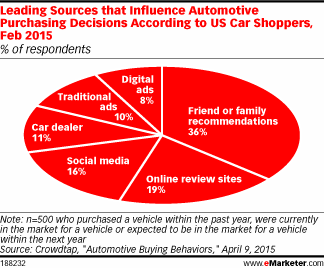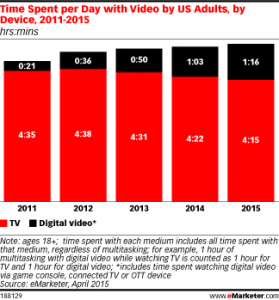 Another week has gone by, and another Google algorithm update has been rolled out. This was, of course, the highly anticipated (and, frankly, very smart) Google “Mobilegeddon.” The good news is that webmasters are paying attention to this update, as Google reports there are 4.7% more mobile-friendly websites than there were two months ago. If you don’t have your digital properties optimized for mobile, there’s no time to waste, as this will absolutely impact how your site appears in mobile search results.
Another week has gone by, and another Google algorithm update has been rolled out. This was, of course, the highly anticipated (and, frankly, very smart) Google “Mobilegeddon.” The good news is that webmasters are paying attention to this update, as Google reports there are 4.7% more mobile-friendly websites than there were two months ago. If you don’t have your digital properties optimized for mobile, there’s no time to waste, as this will absolutely impact how your site appears in mobile search results.
Speaking of mobile, Google also launched Project Fi, its own branded mobile phone service. Time will tell whether they can take meaningful share from Verizon and AT&T, but it’s an interesting move. More deets on this below.
Those are but two of the stories we have for you in this week’s edition of “Things You Need To Know.” Let’s get to it.
Industry
Google Rolls Out Mobile Friendly Search
As mentioned above, this week Google rolled out its latest algorithm update which impacts the way it looks at mobile websites, and how a site ranks in search results. The more mobile-friendly the site, the higher it will appear in the search results on a mobile device, specifically on a smartphone.
“Today’s the day we begin globally rolling out our mobile-friendly update,” Google said in a blog post Tuesday. “Now searchers can more easily find high-quality and relevant results where text is readable without tapping or zooming, tap targets are spaced appropriately, and the page avoids unplayable content or horizontal scrolling.”
The update affects only search rankings on mobile devices and applies to individual pages, rather than entire websites. That is, a site may not be mobile-friendly as a whole but still score high in search results because certain of its pages do.
To determine whether a webpage meets Google’s new criteria, you can enter its name at the company’s Mobile-Friendly Test page. Just type the name of the page, such as V3B.com, and Google will tell you if it’s up to par. If it’s not, Google will pinpoint any problems it finds and even suggest ways to make the site more mobile friendly.
Millennials
Millennials Increasingly Turning To Mobile When Car Shopping

via eMarketer
According to recent data from Edmunds. Com, Millennial behavior indicates mobile research is integral to the car-buying process. While auto advice from family and friends remains welcome, this group is increasingly turning to mobile before purchasing, resulting in 73 percent of U.S. Millennials claiming they are “savvier” car buyers than their parents.
In an April 2015 study from Crowdtap, 36 percent of American car shoppers reported “friend or family recommendations” as the most influential source in decision-making. And Millennials surveyed in March 2015 by Edmunds were willing to comply—more than half of 18- to 34-year-olds said they “actively advise family and friends” looking to purchase a car, compared with 37 percent of the older respondents.
October 2014 research by Millward Brown Digital confirmed Millennials are more apt to go mobile when auto shopping. When asked which screen they used while shopping for a car, Millennials were nearly twice as likely to use a smartphone as Gen X’ers, at 29 percent vs. 15 percent respectively, though 12 percent of both groups reported using a tablet.
Millennials Use Mobile To Research Purchases But Not So Much To Buy
According to a new eMarketer report, “Millennials and Social Media: Gauging How Facebook and Other Networks Fit in Their Lives,” many Millennials use social networks as a research resource when shopping, or simply to express their opinions about brands. They don’t necessarily want to find brands interacting with them there.
On social, Millennials learn about products through peer activity. Nearly half said they did so from “someone else following/‘liking/pinning/tweeting info on social media.”
In addition, the report indicates that Millennials make more general use of social media to research possible purchases.
Millennials who use social sites to transact purchases are the exception, according to August 2014 Harris Poll research for DigitasLBi. One-third of U.S. Millennials said they “would consider making a purchase on a social media site.” Just over one in 10 had bought that way.
Mobile
Google’s New Cellphone Wireless Service Launches

via Marketing Land
Google has now launched its anticipated own wireless service called Project Fi. Details are on the Google Blog, as well as a new Fi website, It’s currently in early beta and only available on the Nexus 6. If you live where they have coverage and want to check it out, you can request an invite for early access.
Google’s service taps into two different 4G LTE providers, depending on where it is used. In the U.S. that’s expected to involve T-Mobile and Sprint.
Plans begin at $30 per month — $20 for the base service and $10 for 1GB per data. Additional data costs $10 per GB. Unlimited talk and text in the U.S. is offered, as well as unlimited text outside the U.S., and “low-cost” international calls. Coverage is promised in 120+ companies and data can be used outside the U.S. with no extra charge. Wifi tethering/hotspot usage is included. Any unused data is refunded on a pro-rated basis at the end of the month, which is starting to be the norm with some of these carriers and is a move long overdue.
Google has characterized what will probably be called “Google Wireless” as a “small experiment.” The company has positioned the new service this way to avoid threatening incumbent wireless carriers. Yet the service could ultimately become a real threat.
Mobile Rules in Time Spent on Retail Sites But More Sales Still Happen on the Desktop
According to a recent comScore study, smartphones and tablets accounted for 60 percent of time spent engaging with digital retail content in Q4 2014, vs. 40 percent for desktop. However, there was a 47 percent monetization gap between the two, with desktop taking 87 percent of digital retail dollars, leaving mobile to account for just 13 percent of the total $82.8 billion U.S. retail e-commerce sales in the final quarter of last year.
Even if digital buyers do take the plunge on mobile, they’re likely not spending as much. Research released in February 2015 by Monetate showed average order value was consistently higher for purchases made via desktop or laptop than for those on a smartphone or tablet. In Q4 2014, the average e-commerce order value in the U.S. was $127.28 on PCs, compared with $113.10 on smartphones and $80.69 on tablets.
Media
U.S. Adults Spend 5.5 Hours Daily Engaging with Video Content

via eMarketer
According to new figures from eMarketer, adults in the U.S. will spend, on average, 5 hours and 31 minutes watching video every day this year, and it’s digital video viewing across devices driving this growth. In 2011, time spent with video on digital devices totalled 21 minutes daily. That is a massive change!
Meanwhile, the average time U.S. adults spent watching video programming on televisions totalled 4 hours and 35 minutes in 2011 and will decline to 4 hours, 15 minutes in 2015. In total, time spent with video on all devices is up from 4 hours, 56 minutes in 2011.
Video is seeing gains on all digital devices this year, with the exception of desktops and laptops, which remain flat. Time spent watching video on mobile devices will increase from 30 minutes daily among adults in 2014, to 39 minutes per day this year. Average daily video time on other connected devices across the U.S. adult population will increase from nine minutes a day last year to 13 minutes in 2015.
The drop in TV time hasn’t stopped marketers from pouring significant amounts of money into television advertising. “Advertisers continue to trust TV despite its limitations, and despite a proliferation of digital alternatives,” said Paul Verna, senior analyst at eMarketer. “The resilience of TV comes partly from inertia, but also from marketers’ concerns that digital video ads aren’t always viewable or watched to completion. Until the digital advertising industry overcomes these hurdles, dollars will continue to flow disproportionately to TV.” I don’t know about you, but when I’m watching video on a device and am presented with an ad, the minute I can hit “skip this ad,” I do. From my focus group of one, it appears that marketers’ concerns re consumers watching video ads are correct. Are you with me on this or do you watch video ads in their entirety?
Media Companies Hate Verizon’s New Mini TV Bundles
As media companies protest, Verizon is holding steady, and defending its new, cheaper cable packages that let customers choose groups of channels. Verizon’s chief financial officer said in a conference call Tuesday that the new packages are allowed “under our existing contracts.”
The plans were rolled out Sunday and start at $55 a month for a basic tier of 35 channels that include broadcast networks and news, as well as Food Network, HGTV, and AMC. They also offer two themed channel packs, such as sports or lifestyle channels.
ESPN, owned by The Walt Disney Co., objects to the new, more customizable option, saying ESPN and ESPN2 can’t be in a separate sports package according to its contract with Verizon. Fox Sports, owned by 21st Century Fox, says Verizon’s new packages also violate agreements, and will continue to talk with the company. NBCUniversal, which is owned by cable company Comcast, also says the new FiOS deals violate agreements.
ESPN is by far the most expensive basic cable network for distributors, according to estimates from data provider SNL Kagan, while Fox Sports 1 and ESPN2 are also in the top 10.
Social Publishing
Blogging Platform Medium Now Lets You Block Other Users

via TNW
On the popular social blogging platform Medium, you can now block a user by visiting their profile, going to “option to follow,” and instead clicking the “Block this user” button. You’ll also see the option within the “More” menu at the bottom of a post.
Once you block a user, they can’t see your profile, follow you, or see your posts while logged in. In the same vein, you won’t be able to see any of their notes, and most posts will be filtered from feeds and searches. However, you’ll still be able to manually view their profile and posts. You can access a list of all your blocked accounts in your settings menu. Apparently this was a necessary thing – but I’m not sure why. Would love to hear from Medium users, contributors on this for your thoughts.
Google Allows Users to Download Their Entire Search History
Google recently added another option to its Takeout service, letting users export data from their Google accounts. The latest addition is one of the most important: Your Google search history.
According to the Google Operating Systems Blog, Google hasn’t added search to its Takeout dashboard yet, so you’ll have to go to the Google History page to grab your search archive. Once you’re there and signed in, click on the settings cog in the upper right corner and select Download.
If you’re comfortable with all of Google’s warnings, hit Create Archive at the bottom of the window. Google generates your archive, and notifies you by email when it’s ready.
You can view the files that make up your search history in Drive — a folder called Takeout — or download them directly from Gmail. This could be interesting on a couple of fronts. When I’m looking for something I’ve searched and can’t find it, it could be very helpful. Additionally, as a parent, it could come in handy when it comes to paying attention to what your kids are doing online and keeping them safe. I have personal experience with this from back in the day, when my older kids were teens – accessing search history by accident allowed me to discover a problem and to put systems in place that helped protect my naïve girl.
Twitter’s Updates Direct Messaging Feature To Allow For More Interaction
Twitter is rolling out a trio of small tweaks to its Direct Messages feature. Users can now send DMs to any of their followers, even if they don’t follow back. Or, they can choose to receive direct messages from anyone using Twitter.
While this might allow followers to take public disputes to a more private sphere, there has been a lot of chatter from Twitter users who absolutely DO NOT want anyone and their dog to be able to DM them. Especially brands. The issue lies with the usability of the new feature: You have the ability to either opt in – or opt out. There’s no middle ground. If you do want to allow certain brands and/or people to DM you, but not others…? Well, that function just isn’t there yet. An update to Twitter’s iOS and Android apps also adds a Direct Messages button to user profiles for easier access. As an individual, I hate this change. As a marketer who handles social media community work for brands, I can see great value.
Facebook Looking to Take a Larger Share of Video Ad Campaigns
Nearly nine out of 10 U.S. advertising executives polled said they planned to run a video ad campaign on Facebook in the coming year—the highest response rate yet out of all networks studied and up from the fewer than two-thirds who had done so in the past year.
Instagram, Twitter, and LinkedIn also saw strong growth in the percentage of respondents who planned to use each platform to run video ads.
This year, eMarketer estimates that 157.1 million American consumers—60.5 percent of internet users and overall nearly half the population—access Facebook at least once per month. By 2019, it’s predicted that 51.8 percent of the U.S. population (62.1 percent of Internet users,) will be Facebookers.
Meerkat
Meerkat is Coming Soon to an Android Phone Near You

via Mashable
Meerkat announced Wednesday that Android users can now sign up for the beta version of the Android app. The company had previously confirmed an Android version of the live-streaming video app was in the works, but this is the first time it has announced the availability of a public beta.
Android users who want to get their hands on the early version of the app can sign up here for access.
Miscellaneous

